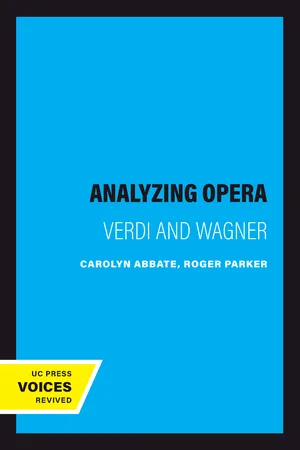
- 316 pages
- English
- ePUB (mobile friendly)
- Available on iOS & Android
About this book
Analyzing Opera: Verdi and Wagner explores the latest developments in opera analysis by considering, side by side, the works of the two greatest opera composers of the nineteenth century. Although the juxtaposition is not new, comparative studies have tended to view these masters as radically different both as musicians and as musical dramatists. Wagner and his "symphonic opera" set against Verdi "the melodist" is one of many familiar antitheses, and it serves to highlight the particular terms from which comparisons are often made. In this book some of the leading and most innovative music scholars challenge this view, suggesting that as we become more distant from the nineteenth century, we may see that Verdi and Wagner confronted largely similar problems, and even on occasion found similar solutions.But more than this, Analyzing Opera sets out to demonstrate the richness and variety of modern analytical approaches to the genre. As the editors point out in their introduction, today's musical scholars increasingly question the usefulness of organicist theories in analytical studies, and, as they do so, opera seems to become an ever more central area of investigation. Opera is peculiar: its clash of verbal, musical, and visual systems can produce incongruities and extravagant miscalculations. It invites a multiplicity of approaches, challenges orthodoxy, and embraces ambiguity. The sheer variety of essays presented here is witness to this fact and suggests that analyzing opera is one of the liveliest (and most polemical) areas in modern-day musical scholarship.Contributors: Philip Gossett, John Deathridge, James A. Hepokoski, Joseph Kerman, Thomas S. Grey, Matthew Brown, Anthony Newcomb, Martin Chusid, David Lawton, and Patrick McCreless.
Analyzing Opera: Verdi and Wagner explores the latest developments in opera analysis by considering, side by side, the works of the two greatest opera composers of the nineteenth century. Although the juxtaposition is not new, comparative studies have ten
Frequently asked questions
- Essential is ideal for learners and professionals who enjoy exploring a wide range of subjects. Access the Essential Library with 800,000+ trusted titles and best-sellers across business, personal growth, and the humanities. Includes unlimited reading time and Standard Read Aloud voice.
- Complete: Perfect for advanced learners and researchers needing full, unrestricted access. Unlock 1.4M+ books across hundreds of subjects, including academic and specialized titles. The Complete Plan also includes advanced features like Premium Read Aloud and Research Assistant.
Please note we cannot support devices running on iOS 13 and Android 7 or earlier. Learn more about using the app.
Information
Table of contents
- Cover
- Title
- Copyright
- Contents
- Acknowledgments
- A Note on Citations
- Introduction On Analyzing Opera
- Chapter 1 The Composition of Ernani
- Chapter 2 Through the Looking Glass Some Remarks on the First Complete Draft of Lohengrin
- Chapter 3 Opera as Symphony, a Wagnerian Myth
- Chapter 4 Verdi’s Composition of Otello The Act II Quartet
- Chapter 5 Verdi’s Groundswells Surveying an Operatic Convention
- Chapter 6 Isolde’s Narrative From Hauptmotiv to Tonal Model
- Chapter 7 Ritornello Ritornato A Variety of Wagnerian Refrain Form
- Chapter 8 Motives and Recurring Themes in Aida
- Chapter 9 The Tonality of Rigoletto
- Chapter 10 Tonal Systems in Aida, Act III
- Chapter 11 Schenker and the Norns
- Index